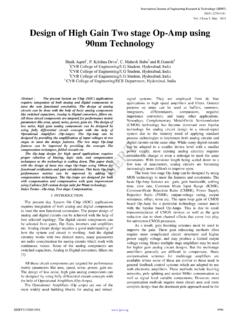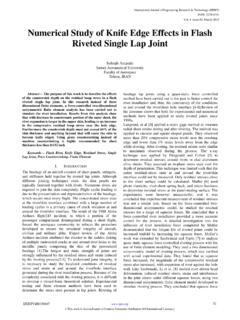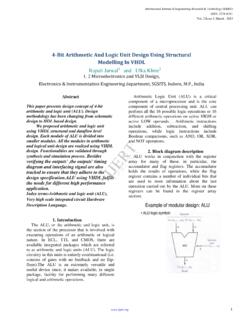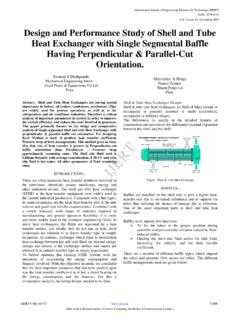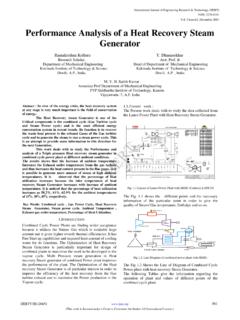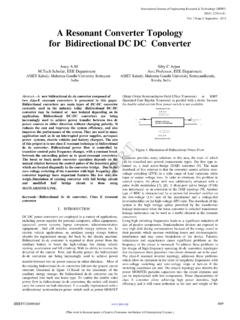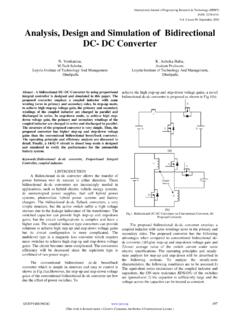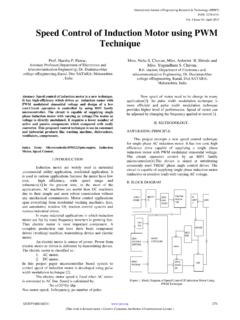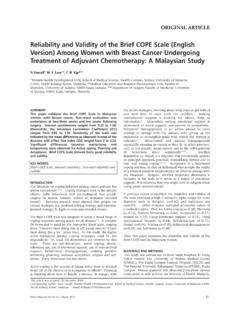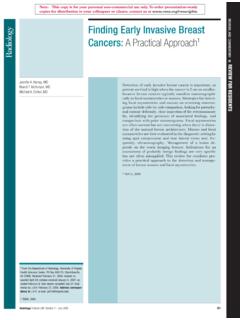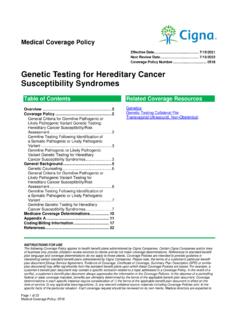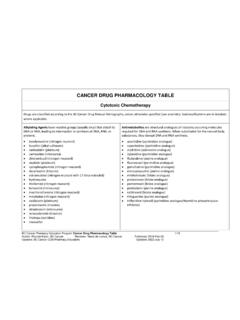Transcription of Breast Cancer Classification and Prediction using ... - IJERT
1 Breast Cancer Classification and Prediction using Machine Learning Nikita Rane Dept. of Information Technology, Xavier Institute of Engineering, Mumbai - 400016, India Jean Sunny Dept. of Information Technology Xavier Institute of Engineering, Mumbai - 400016, India Rucha Kanade Dept. of Information Technology, Xavier Institute of Engineering, Mumbai - 400016, India Prof. Sulochana Devi Dept. of Information Technology, Xavier Institute of Engineering, Mumbai - 400016,India. Abstract Breast Cancer is a dominant Cancer in women worldwide and is increasing in developing countries where the majority of cases are diagnosed in late stages. The projects that have already been proposed show a comparison of machine learning algorithms with the help of different techniques like the ensemble methods, data mining algorithms or using blood analysis etc.
2 This paper proposed now presents a comparison of six machine learning (ML) algorithms: Naive Bayes (NB), Random Forest (RT), Artificial Neural Networks (ANN), Nearest Neighbour (KNN), Support Vector Machine (SVM) and Decision Tree (DT) on the Wisconsin Diagnostic Breast Cancer (WDBC) dataset which is extracted from a digitised image of an MRI. For the implementation of the ML algorithms, the dataset was partitioned into the training phase and the testing phase. The algorithm with the best results will be used as the backend to the website and the model will then classify the Cancer as benign or malignant. Keywords - Breast Cancer Classification , Breast Cancer Prediction , benign, malignant, Na ve Bayes, KNN, Support Vector Machine, Artificial Neural Network, Random Forest, Decision tree, SQLA lchemy.
3 Research paper has gathered information from ten different papers based on Breast Cancer using machine learning and other techniques such as ultrasonography, blood analysis etc. The project by S. Gokhale, is using the ultrasonography(USG) technique which is a powerful method in detecting details about the Breast mass that usually cannot be detected even by mammography. Another project by Pragya Chauhan and Amit Swami, which is based on the ensemble method usually used to increase the Prediction accuracy of Breast Cancer . A Genetic algorithm based weighted average method that includes crossover and mutation is used for the Prediction of multiple models. Further more, a project by Abien Fred M. Agarap uses different methods like GRU-SVM, NN, multilayer perceptron (MLP), softmax regression to classify the dataset into benign or malignant.
4 A project by Priyanka Gupta shows the comparison of the lesser invasive techniques such as Classification and Regression Trees (CART), random forest, nearest neighbour and boosted trees. These four Classification models are chosen to extract the most accurate model for predicting Cancer survivability rate. Another project by Muhammet Fatih Aslan, Yunus Celik , and Kadir Sabanci, Akif Durdu that uses the blood analysis dataset from UCI. It draws results that are from methods like Extreme Learning Machine (ELM), ANN etc. it also has an added MATLAB GUI environment that for Classification with ANN. Further more, a project by Yixuan Li and Zixuan Chen shows a performance evaluation using three indicators including Prediction accuracy values, F-measure metric and AUC values are used to compare the performance of these five Classification models.
5 Other experiments show that random forest model can achieve better performance and adaptation than other four methods. A project by Mumine Kaya Keles, which is a comparative study of data mining Classification algorithms. Another project by Sang Won Yoon and Haifeng Wang that uses four data mining models are applied in this paper, , support vector machine (SVM), artificial neural network (ANN), Naive Bayes classifier, AdaBoost tree. Furthermore, feature space is highly deliberated in this paper due to its high imapct on the efficiency and effectiveness of the learning process. Lastly a project by Wenbin Yue and Zidong Wang that shows the algorithms that helped them with the diagnosis and prognosis of their dataset. OF LITERATUREU ltrasound characterisation of Breast masses by S.
6 Gokhale written by proposed a system where they found that doctors have known and experienced that Breast Cancer occurs when some Breast cells begin to grow abnormally. These cells divide more briskly and disperse faster than healthy cells do and continue to accumulate, form- ing a lump or mass that the may start causing pain. Cells may spread rapidly through your Breast to your lymph nodes or to other parts of your body. Some women can be at a higher risk for Breast Cancer because of their family history, lifestyle, obesity, radiation, and reproductive factors. In the case of Cancer , if the diagnosis occurs quickly, the patient can be saved as there have been advances in Cancer treatment. In this study we use four machine learning classifiers which are Naive Bayesian Classifier, k-Nearest Neighbour, Support Vector Machine, Artificial Neural Network and random forest.
7 International Journal of Engineering Research & Technology ( IJERT )ISSN: 2278-0181 (This work is licensed under a Creative Commons Attribution International License.)Published by 9 Issue 02, February-2020576 Harmonic imaging and real-time compounding has been shown to enhance image resolution and lesion characterisation. More recently, USG elastography seems to be quite ncouraging. Initial results show that it can improve the specificity and positive predictive value of USG within the characterisation of Breast masses. The reason why any lesion is visible on mammography or USG is that the relative difference within the density and acoustic resistance of the lesion, respectively, as compared to the encompassing Breast tissue. [1] Breast Cancer Prediction using Genetic Algorithm Based Ensemble Approach written by Pragya Chauhan and Amit Swami proposed a system where they found that Breast Cancer Prediction is an open area of research.
8 In this paper dierent machine learning algorithms are used for detection of Breast Cancer Prediction . Decision tree, random forest, support vector machine, neural network, linear model, adabost, naive bayes methods are used for Prediction . An ensemble method is used to increase the Prediction accuracy of Breast Cancer . New technique is implemented which is GA based weighted average ensemble method of Classification dataset which over- came the limitations of the classical weighted average method. Genetic algorithm based weighted average method is used for the Prediction of multiple models. The comparison between Particle swarm optimisation(PSO), Dierential evolution(DE) and Genetic algorithm(GA) and it is concluded that the genetic algorithm outperforms for weighted average methods.
9 One more comparison between classical ensemble method and GA based weighted average method and it is concluded that GA based weighted average method outperforms. [2] On Breast Cancer Detection: An Application of Machine Learn ing Algorithms on the Wisconsin Diagnostic Dataset by the Abien Fred M. Agarap. In this paper, six machine learning algorithms are used for detection of Cancer . GRU-SVM model is used for the diagnosis of Breast Cancer GRU-SVM, Linear Regression, Multilayer Perceptron (MLP), Nearest Neighbour (NN) search, Softmax Regression, and Support Vector Ma- chine (SVM) on the Wisconsin Diagnostic Breast Cancer (WDBC) dataset by measuring their Classification test accuracy, and their sensitivity and specificity values. The said dataset consists of features which were computed from digitised images of FNA tests on a Breast mass.
10 For the implementation of the ML algorithms, the dataset was partitioned in the following fashion 70 percent for training phase, and 30 percent for the testing phase. Their results were that all presented ML algorithms exhibited high performance on the binary Classification of carcinoma, determining whether benign tumour or malignant tumour. Therefore, the statistical measures on the Classification problem were also satisfactory. To further corroborate the results of this study, a CV technique such as k-fold cross-validation should be used. The appliance of such a way won't only provide a more accurate measure of model Prediction performance, but it'll also assist in determining the foremost optimal hyper-parameters for the ML algorithms. [3] Analysis of Machine Learning Techniques for Breast Cancer Prediction by the Priyanka Gandhi and Prof.

